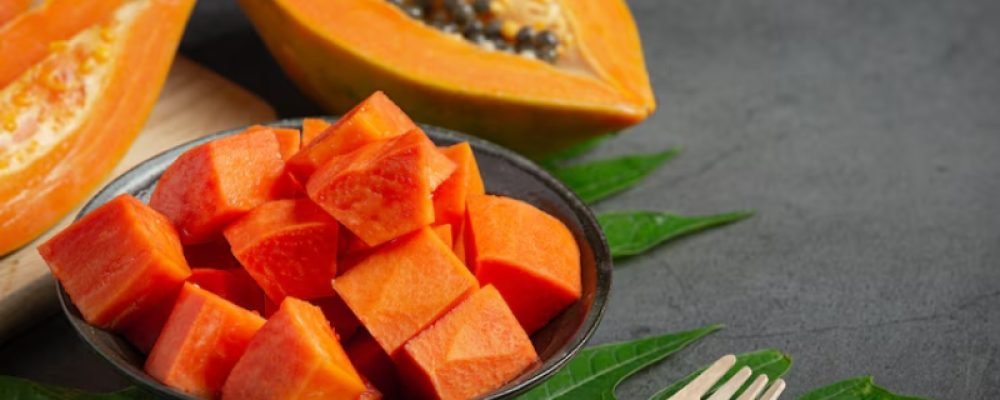
Managing diabetes doesn’t mean eliminating fruits from your diet—it means choosing the right ones in the right portions. One common question among diabetics is: Is papaya good for diabetes? This tropical fruit is tasty, hydrating, and packed with nutrients, but how does it impact blood sugar? In this guide, we’ll dive deep into papaya’s nutritional profile, glycemic index, benefits, and safety for diabetics.
Fruits contain natural sugars, which can affect blood sugar levels. However, they also provide dietary fiber, vitamins, antioxidants, and other essential nutrients that support overall health.
For diabetics, fiber and antioxidants are especially important because they help regulate blood glucose and reduce inflammation. But the type of fruit and how it affects blood sugar (based on its glycemic index) is critical to know.
So, let’s explore the real question: Is papaya good for diabetes?
According to the U.S. Department of Agriculture (USDA) and WebMD:
Source:
• WebMD: Papaya – Health Benefits and Nutrition
This nutrient mix makes papaya especially good for immunity, heart health, digestion, and skin. But for people with diabetes, the sugar, fiber, and glycemic index are the most important aspects.
The glycemic index (GI) is a ranking system that measures how quickly carbohydrate-containing foods raise blood sugar levels.
‣ Low GI: 55 or less
‣ Medium GI: 56–69
‣ High GI: 70 or above
Papaya has a GI of around 60, placing it in the medium GI range. However, it also has a low glycemic load (GL) because of its water and fiber content, making it less likely to cause sharp blood sugar spikes when eaten in moderation.
So, is papaya good for diabetes in terms of glycemic index? Yes, it can be part of a balanced diabetic diet when portion-controlled.
Papaya is rich in flavonoids and carotenoids, particularly beta-carotene, lutein, and zeaxanthin, which are powerful antioxidants that help reduce oxidative stress—a key contributor to insulin resistance and diabetic complications. According to WebMD, these compounds also support eye health and immune function.
One cup of papaya offers over 100% of your daily Vitamin C intake. Vitamin C is vital for wound healing, immunity, and reducing inflammation—which benefits diabetic patients who are prone to slower healing and higher inflammation levels.
Papaya has 2.5 to 3 grams of fiber per cup, which helps regulate digestion and slows the absorption of sugar into the bloodstream. This means better post-meal blood sugar control for people with diabetes.
Papain, a unique enzyme found in papaya, supports digestion and helps break down proteins. Better digestion means more efficient nutrient absorption and a more stable blood sugar level over time.
Some small-scale studies and traditional uses suggest papaya may have mild blood-sugar-lowering effects, although larger human studies are needed. This hypoglycemic effect is likely due to its natural phytochemicals and antioxidants.
Conclusion: Based on all these factors, yes, papaya is good for diabetes—when consumed in moderation and paired with other blood-sugar-friendly foods.
To maximize the benefits of papaya without spiking blood sugar, follow these simple guidelines:
While papaya is generally safe, some groups should be cautious:
Consult your doctor or dietitian before making papaya a regular part of your diabetic diet plan.
Let’s see how papaya compares with other commonly consumed fruits:
| Fruit | Glycemic Index (GI) | Safe for Diabetes? |
|---|---|---|
| Papaya | ~60 (Medium) | In moderation |
| Apple | ~36 (Low) | Excellent choice |
| Banana | ~62 (Medium) | Only in small amounts |
| Grapes | ~53 (Low) | Safe, but watch portion size |
| Watermelon | ~72 (High) | Eat rarely, spikes sugar quickly |
| Mango | ~60 (Medium) | Eat small servings |
| Guava | ~31 (Low) | One of the best fruits for diabetes |
| Strawberries | ~41 (Low) | Very good |
As you can see, papaya fits well into a medium-GI fruit category—not as ideal as berries or apples, but significantly better than pineapple or watermelon.
Here are some creative ways to enjoy papaya safely:
If you’re looking for lower GI fruits than papaya, try:
All of these are low GI and high in fiber, making them excellent options for tight blood sugar control.
Yes, but limit to ½–1 cup daily. Make sure to monitor your blood glucose and pair it with protein or fat.
Not significantly. It has a moderate glycemic index and is unlikely to cause a blood sugar spike in small portions.
Raw papaya contains less sugar but is not as commonly consumed. Ripe papaya is safe in moderation.
Morning or midday, when insulin sensitivity is higher.
Early research and traditional use suggest possible mild hypoglycemic effects, but more studies are needed.
After analyzing its nutritional value, glycemic impact, and health benefits, the verdict is clear: Yes, papaya is good for diabetes if consumed wisely. Its moderate glycemic index, high fiber content, and antioxidant properties make it a smart fruit choice for diabetics. Just remember to control portion sizes, avoid fruit juices, and pair papaya with foods that help stabilize blood sugar levels.
For personalized diabetes care, diet plans, and expert guidance, explore our services at diabetologist in thane
Service Road, Ghodbunder Rd, next to AP Shah Institute of Technology, Kasarvadavali, Thane West, Maharashtra 400615
Pioneering Excellence in Neurology and Neurosurgery with Cutting-Edge Technology and Compassionate Care. Solaris Hospital is your one-stop destination for comprehensive with wide range of multi-specialty services.
Service Road, Ghodbunder Rd,
next to AP Shah Institute of
Technology, Kasarvadavali,
Thane (West),
Maharashtra. 400615
Phone:+91 22 4004 4001 / 4004 4003 / 8655696500
E-mail:contact@solarishospitals.com
